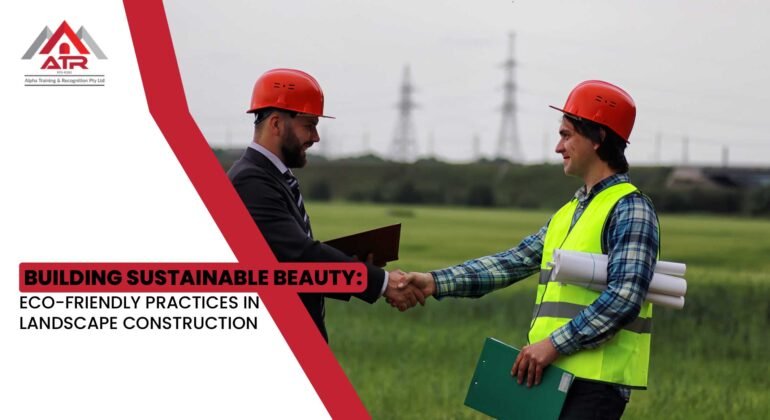Overview:
Delve into the world of eco-friendly landscape construction with a focus on sustainability. In this comprehensive guide, we explore eco-friendly practices, construction techniques, and horticultural principles essential for creating beautiful and environmentally responsible outdoor spaces. From plant propagation to green building materials, discover how to build sustainable beauty in landscape construction.
- Understanding Certificate III in Landscape Construction
Certificate III in Landscape Construction (AHC30921) lays the groundwork for a rewarding career in landscape construction. This qualification equips individuals with the knowledge and skills needed to design, construct, and maintain outdoor spaces using sustainable practices. Think of AHC30921 as a passport to a world where creativity meets environmental stewardship – just as a passport grants access to new horizons, this certification opens doors to opportunities in sustainable landscaping and green infrastructure development.
- Exploring Sustainable Landscaping Principles
Sustainable landscaping prioritizes environmental conservation, resource efficiency, and biodiversity enhancement. By incorporating native plants, minimizing water use, and reducing chemical inputs, sustainable landscapes promote ecosystem health and resilience. Imagine a lush rainforest ecosystem teeming with diverse plant and animal life – similarly, a sustainable landscape mimics nature’s harmony, fostering biodiversity and ecological balance for the benefit of all living beings.
- Mastering Construction Techniques for Eco-Friendly Landscapes
Eco-friendly construction techniques minimize environmental impact and maximize resource efficiency. From using permeable paving to reduce stormwater runoff to incorporating recycled materials into hardscape features, green construction practices prioritize sustainability at every stage of the landscape installation process. Envision a skilled artisan sculpting a masterpiece from reclaimed wood and stone – similarly, a conscientious landscape constructor transforms outdoor spaces with creativity and ingenuity, using sustainable materials and techniques to minimize ecological footprint and promote long-term environmental health.
- Harnessing the Power of Green Infrastructure
Green infrastructure refers to natural or engineered systems that manage stormwater, mitigate urban heat island effects, and enhance biodiversity in urban areas. Sustainable landscape construction integrates green infrastructure elements such as bioswales, rain gardens, and green roofs to improve water quality, reduce flooding, and create habitat for wildlife. Think of green infrastructure as a green oasis amidst concrete jungles, providing respite for humans and wildlife alike – just as an oasis sustains life in the desert, green infrastructure sustains urban ecosystems, fostering resilience and sustainability in cities and towns.
- Embracing Horticultural Practices for Sustainability
Horticulture plays a pivotal role in sustainable landscape construction, providing the foundation for healthy and vibrant outdoor spaces. By practicing plant propagation, soil management, and integrated pest management, landscape constructors promote plant health and reduce reliance on synthetic inputs. Imagine a gardener nurturing seedlings in a greenhouse, cultivating life from tiny seeds – similarly, a skilled landscape constructor propagates plants with care and expertise, nurturing greenery that thrives in harmony with the natural environment.
- Designing Water-Efficient Irrigation Systems
Water-efficient irrigation systems are essential for sustainable landscape management, delivering water precisely where and when it’s needed while minimizing waste and runoff. Techniques such as drip irrigation, smart controllers, and rainwater harvesting help conserve water resources and promote plant health. Envision a wise steward distributing water evenly to thirsty plants, ensuring their vitality while conserving precious water – similarly, a savvy landscape constructor designs irrigation systems that optimize water use, balancing the needs of plants with the constraints of water availability to create landscapes that flourish sustainably.
- Selecting Native Plants for Biodiversity
Native plants are the backbone of sustainable landscapes, adapted to local climates, soils, and ecosystems. By selecting native species for landscaping projects, constructors enhance biodiversity, support pollinators, and reduce the need for supplemental irrigation and fertilization. Think of native plants as the threads that weave together the fabric of local ecosystems, providing food, shelter, and habitat for wildlife – just as threads interlace to form a tapestry, native plants create vibrant and resilient landscapes that thrive in harmony with nature.
- Utilizing Green Building Materials
Green building materials are essential for sustainable landscape construction, offering durability, low environmental impact, and aesthetic appeal. From recycled plastics and composite lumber to sustainably harvested timber and permeable pavers, green materials contribute to eco-friendly landscapes that blend seamlessly with the natural surroundings. Imagine a craftsman building a sustainable structure using reclaimed materials, honoring the past while embracing the future – similarly, a conscientious landscape constructor selects green building materials that minimize environmental footprint and maximize beauty and functionality in outdoor spaces.
- Promoting Soil Health and Fertility
Soil health is the foundation of sustainable landscapes, supporting plant growth, nutrient cycling, and water infiltration. By practicing soil conservation techniques, such as mulching, composting, and cover cropping, landscape constructors improve soil structure, fertility, and resilience to environmental stressors. Envision a farmer tending to the earth, enriching soil with organic matter to nurture crops – similarly, a dedicated landscape constructor cares for the soil, replenishing its nutrients and microbial life to create a thriving environment for plants and microorganisms alike.
- Integrating Artistic Installations with Environmental Sensibility
Artistic installations add visual interest and creative flair to landscapes, enhancing their beauty and functionality. Sustainable landscape constructors integrate artistic elements such as sculptures, mosaics, and living walls with environmental sensibility, using eco-friendly materials and techniques that harmonize with the natural surroundings. Think of an artist sculpting a masterpiece from natural materials found in the landscape; similarly, a visionary landscape constructor creates artful installations that celebrate nature’s beauty and inspire awe while preserving ecological integrity and promoting sustainability.
In conclusion:
building sustainable beauty in landscape construction requires a holistic approach that integrates ecological principles, construction techniques, horticultural practices, and artistic sensibility. By embracing sustainability at every stage of the landscape construction process, from design and installation to maintenance and management, landscape constructors can create outdoor spaces that are not only aesthetically pleasing but also ecologically resilient, socially equitable, and economically viable. With AHC30921 certification as their guide, they can embark on a journey of creativity, innovation, and environmental stewardship, shaping landscapes that reflect the harmony and balance of nature.



